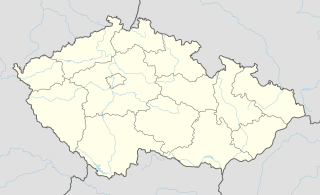Punkevní jeskyně
| Punkevní jeskyně
|
||
|---|---|---|
| Location: | east of Blansko , Czech Republic | |
|
Geographic location: |
49 ° 22 '11.3 " N , 16 ° 43' 31.4" E | |
|
|
||
| Type: | Stalactite cave | |
| Discovery: | 1909 | |
| Show cave since: | 1914 | |
| Lighting: | electric | |
| Overall length: | 32,500 m | |
| Length of the show cave area: |
1250 m | |
| Average annual number of visitors: | 200,000 | |
The Punkevní jeskyně (German Punkwahöhlen ) are located in the northern part of Moravian Switzerland in the national nature reserve Vývěry Punkvy east of the city of Blansko .
The caves form an underwater hydrographic system of the Punkva River and are part of the largest cave system in the Czech Republic . Part of the cave region is also the largest abyss Macocha .
The caves consist of a dry part, which was gradually discovered between 1909 and 1914, and a water part and associated dry caves, which were explored from 1920 to 1933. In some parts you can still discover new corridors today. The total length of the previously discovered and explored cave passages is about four kilometers with a span of over 187 meters.
The dry caves were opened to the public in 1909. The cavities that can be viewed today were opened in 1933; tours on boats have been available since 1920.
The cave passages were formed by the river Punkva, whose source emerges as underground waterfalls at Holštejn and then converges in the amateur cave. During the Macocha earthquake, the river emerges and then flows through the cave passages and the canyon Pustý žleb again.
The cave system is one of the younger caves and gradually arose over several floors. In the case of geological disturbances, there were frequent ceiling collapses and the formation of ravines. Such a disturbance also created the macocha and the high Reichenbachův Dóm. The eighty meter high chimneys, which were created by the vertical influence of the water, are also characteristic.
The caves are rich in stalactites. You can find mighty stalagmites and stalactites, curtains and other sinter formations. The stalagmite angel with extravagant sintered crust and curtains has a unique deformation.
The cave was first explored and mapped by the Czech archaeologist and speleologist Karl Absolon .
Web links
- Punkva River Cave description on ShowCaves.com (English)
- caves.cz

